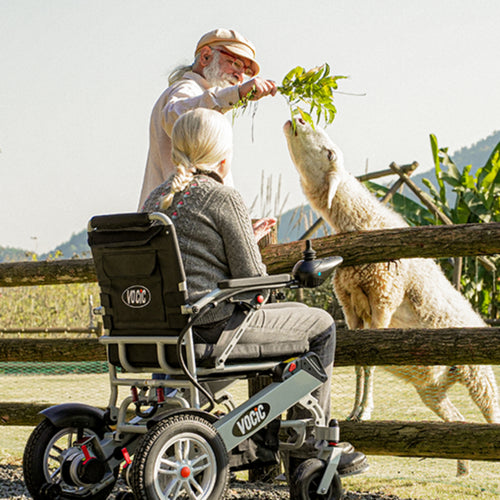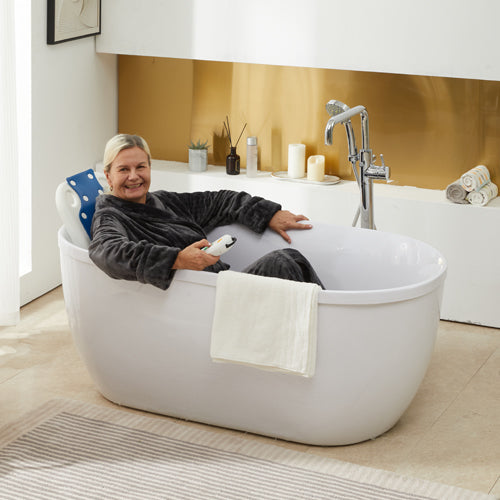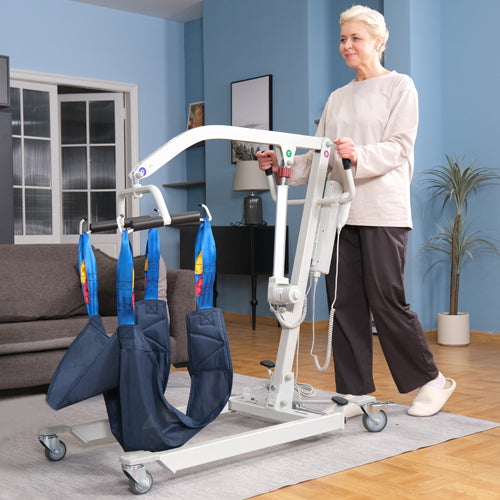For those who spend a lot of time indoors or have mobility challenges, gentle gardening activities like planting flowers or watering plants can offer mild physical exercise, helping to strengthen muscles and improve joint flexibility. Being in nature, listening to birds, and feeling the breeze can also help relieve stress and anxiety, improving overall mental health. For seniors with mobility issues or who need extra support, a 4 wheel walker is an indispensable helper during gardening activities.
Choosing the Right Rollator Walker for Gardening
1. Stability and Durability
A 4 wheel rollator walker is designed for stability, providing reliable support on uneven garden surfaces, helping seniors maintain balance and reducing the risk of falls. When moving around the garden, the walker serves as a safe support point, allowing them to walk confidently on various surfaces, whether it's grass, gravel, or pathways.
Stable materials in 4 wheel rollator walkers include aluminum and carbon fiber, both of which have high strength to withstand significant weight and pressure while being lightweight. Moreover, they have strong corrosion resistance, ensuring stable performance in various weather conditions. You can also click on the article "Which Lightweight Rollator Walker is Better? Aluminum or Carbon Fiber?" to learn more.
2. Solid Rubber Tires and Pneumatic Tires
- Solid Rubber Tires: Solid rubber tires are very durable and suitable for long-term use on various surfaces, making them ideal for those who want to minimize maintenance and ensure long-term use. Especially on harder surfaces or when frequent movement in the garden is required, their durability and puncture resistance are crucial.
- Pneumatic Tires: Pneumatic tires offer better shock absorption, making them suitable for use on garden grass, soil, or uneven surfaces. They effectively absorb ground vibrations, providing a more comfortable experience and reducing impact on the legs. These tires are ideal for gardening on soft soil or grass, offering a comfortable walking experience and reducing body impact. Click here to learn more about "What Type of 4-Wheel Walker Tire is Best for You?"
3. Seat and Storage
Many 4 wheel walkers with a seat offer seniors to take breaks whenever needed, without having to stand or squat continuously. This is especially helpful for those engaged in prolonged gardening activities. The walker’s basket or storage bag can be used to carry tools, seeds, or plants, reducing the burden of carrying items around the garden.
Preparing Your Garden for Accessibility
1. Creating Spacious, Level Pathways
- Ensure Sufficient Width: To accommodate seniors using 4 wheel walkers, wheelchairs, or other assistive devices, garden paths should be wide. This provides enough space for comfortable movement. Wider paths also allow for easy turning, preventing the risk of getting stuck or bumping into obstacles.
- Level Surfaces: Uneven ground can lead to trips or slips, especially for those with mobility challenges. Garden paths should be as level as possible, using non-slip bricks, paving stones, or compacted gravel to ensure stability. If there are ramps, the incline should be gentle to prevent 4 wheel walkers or wheelchairs from losing control on slopes.
2. Choosing the Right Ground Materials
- Non-Slip Materials: Selecting non-slip materials is crucial, especially in wet conditions after rain or watering. Rubber bricks, rough concrete, or specially designed non-slip tiles are excellent choices, offering good traction and reducing the risk of slipping.
- Minimize Obstacles: Avoid placing loose stones or thick layers of leaves on pathways, as these can be tripping hazards. Additionally, regularly trim garden plants to prevent branches or vines from encroaching on paths, ensuring clear passage.
3. Enhancing Garden Visibility
- Clear Pathway Edges: Use materials with contrasting colors or textures to mark the edges of pathways, helping seniors with poor vision better identify the route. Clear visual markers can prevent falls caused by misjudging the path.
- Night Lighting: Installing soft night lighting in the garden helps keep pathways visible as dusk falls, preventing seniors from tripping due to poor lighting.
4. Utilizing Vertical Space for Planting
Vertical planting not only saves space but also raises plants to a more accessible height. This is especially convenient for seniors using a 4 wheel walkers or wheelchairs, as they can water, prune, and harvest without the need to bend or squat.
Tips on Gardening with a Rollator Walker
1. Selecting Suitable Plants and Planting Locations
- Accessible Planting Areas: When planning your garden, prioritize planting areas that are easy to reach and close to pathways, ensuring that seniors using rollator walkers don’t have to overreach or bend too much to tend to the plants. Keeping frequently used tools and plants nearby can improve efficiency and reduce unnecessary physical strain.
- Choosing Low-Maintenance Plants: To reduce the workload, choose plants that are well-suited to the local climate, easy to manage, and resistant to pests and diseases. These plants are easier to care for and can thrive with minimal intervention, allowing seniors to enjoy gardening without becoming overly fatigued.
2. Utilizing the Walker’s Features for Gardening
- Tool Placement: Rollator walkers typically come with baskets or storage bags, which can be used to carry gardening tools, seeds, or small plants. Before starting your gardening tasks, place the necessary tools in the 4 wheel walker’s storage area to ensure everything is within easy reach, avoiding the need to constantly move back and forth.
- Choosing Lightweight Tools: Using lightweight and easy-to-handle gardening tools, such as long-handled trowels or pruners, can reduce the strain on the hands, allowing seniors to operate them single-handedly while using the walker. By carefully selecting tools, the gardening process can be smoother and more comfortable.
3. Avoiding Prolonged Standing or Bending
- Taking Breaks on the Walker’s Seat: Many 4 wheel walkers come with built-in seats, allowing seniors to take breaks as needed. While planting or pruning, sit down on the seat to work, avoiding prolonged standing or bending, which can reduce strain on the back and knees. This not only helps alleviate fatigue but also extends the time spent enjoying gardening.
- Breaking Tasks into Stages: Divide gardening tasks into smaller, manageable steps to avoid overexertion. For example, plant a few plants, take a short break, and then continue. This approach allows better management of energy while enjoying the satisfaction of completing each stage.
4. Maintaining Walker Stability
Before engaging in gardening activities, regularly check the walker’s tires, brakes, and overall structure to ensure its stability and reliability. In the garden, the rollator walker may come into contact with dirt and moisture, so timely cleaning and maintenance can extend its lifespan and ensure safety.









